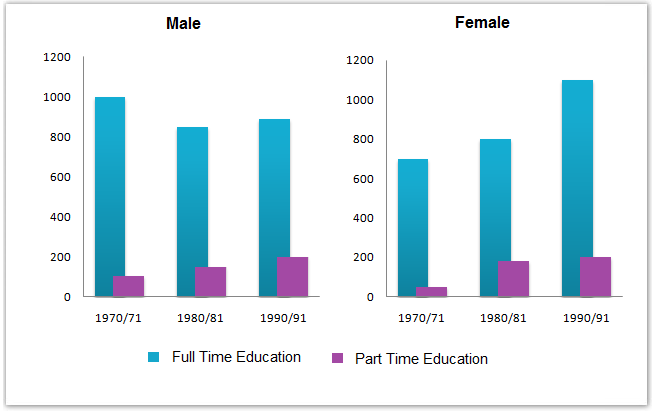Graph Writing # 118 - Men and women in further education in Britain in three periods
- Details
- Last Updated: Tuesday, 28 July 2020 12:34
- Written by IELTS Mentor
- Hits: 184479
IELTS Academic Writing Task 1/ Graph Writing - Column Graph:
» You should spend about 20 minutes on this task.
The chart below shows the number of men and women (in thousand) in further education in Britain in three periods and whether they were studying full-time or part-time.
Summarise the information by selecting and reporting the main features, and make comparisons where relevant.
» Write at least 150 words.

Sample Answer:
The given bar graphs show data on the British people’s full-time and part-time further education from 1970 to 1991. As is presented in the graphs, more men and women were studying full-time than part-time for the given period.
Initially, in 1970 and 1971, about 1000 thousand male were in full-time further education and this number decreased to average 850 thousand for 1980 and 1990. On the contrary, this number for part-time students increased over the time though the number was many times lower than the number of people in full-time education. In 1970, almost 100 thousand people were in part-time education and in next 20 years, this number increased to 200 thousand. On the other hand, in 1970, the total number of females who were engaged in full-time education was 700 thousand and this number increased over time and reached to 11000 thousand in 1990/91 which was even higher than the number of males who were in full-time further education in this year. The female part-time students’ number also increased over time and reached to over 200 thousand in 1990 from the initial number of 20 thousand in 1970.
In summary, females made progress over their male counterparts in terms of their involvement in full-time and part-time education in Britain for the given period.
(Approximately 213 words )

Overall it is crystal clear that part-time education was more common between both genders while full-time education was least over the year.
In terms of males, full-time education decreased gradually every year. In 1970/71, almost 1000,000 male students were engaged in full-time education in Britain. It dropped slightly to near about 850,000 in 1980/81 but in 1990/91, it grew to nearly 900,000. On the other hand, part-time education became more popular among male learners. In 1970/71, male part-time students were below 100 thousand while it rose to over 200 thousand after two decades.
On the contrary, more female learners engaged in both full-time and part-time education over time than they did initially. In 1970/71, their engagement in full-time education was nearly 700 thousand which went as high as 1100 thousand in just twenty years. Their number in part-time education also increased significantly from just 20 thousand to over 200 thousand.
From the illustration, we can see that in the case of males, part-time education was unpopular during the given decades. Its popularity among males decreased from 100 to 90 thousand. And the number of males in full-time education increases from 100 to 300 thousand during the same period. Meanwhile, in the case of females, the trend was exactly the opposite. Their participation in part-time education increased dramatically from 700 to 1100 thousand in three decades. They also showed interest in full-time education. In the 1980-81 session, full-time education participation by females doubled - from 100 to 200 thousand. But in the last decade, it remained the same at 200 thousand.
As is seen, full-time students in further studies in Britain were far higher than those of part-timers but as time progresses, part-time education gradually gained popularity. More importantly, more women participated in further studies than the past while the trend was opposite for the male.
In details, almost one million male in Britain participated in full-time education in 1970/71 while this number was just 100 thousand for part-timer in the same year. On the contrary, female full-timer was about 700 thousand and part-time female students were as low as 50 thousand. Over time, the participating women in further education increased and reached over 1.1 million while the number of male participants actually decreased and dropped to just above 900 thousand after two decades. Women did a remarkable improvement in terms of their involvement in further education in Britain as their number almost doubled in just twenty years. The same cannot be said for the male post-graduate students. Interestingly, part-time further education became more popular over the year as more male, as well as female students, became engaged in it.
Report